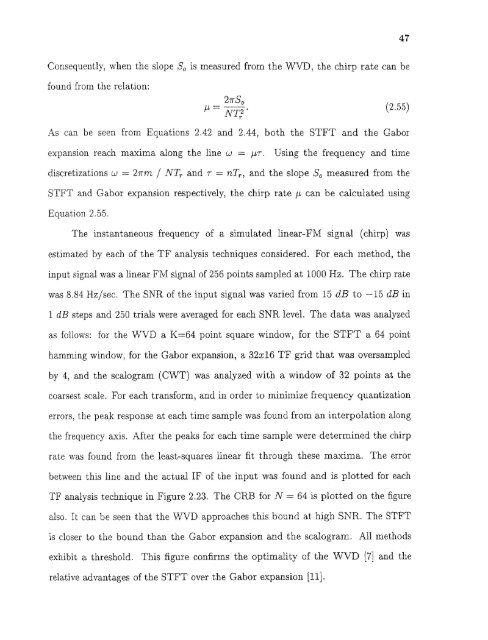Space/time/frequency methods in adaptive radar - New Jersey ...
Space/time/frequency methods in adaptive radar - New Jersey ...
Space/time/frequency methods in adaptive radar - New Jersey ...
Create successful ePaper yourself
Turn your PDF publications into a flip-book with our unique Google optimized e-Paper software.
47Consequently, when the slope S, is measured from the WVD, the chirp rate can befound from the relation:As can be seen from Equations 2.42 and 2.44, both the STFT and the Gaborexpansion reach maxima along the l<strong>in</strong>e w Us<strong>in</strong>g the <strong>frequency</strong> and <strong>time</strong>and the slope S, measured from theSTFT and Gabor expansion respectively, the chirp rate p, can be calculated us<strong>in</strong>gEquation 2.55.The <strong>in</strong>stantaneous <strong>frequency</strong> of a simulated l<strong>in</strong>ear-FM signal (chirp) wasestimated by each of the TF analysis techniques considered. For each method, the<strong>in</strong>put signal was a l<strong>in</strong>ear FM signal of 256 po<strong>in</strong>ts sampled at 1000 Hz. The chirp ratewas 8.84 Hz/sec. The SNR of the <strong>in</strong>put signal was varied from 15 dB to —15 dB <strong>in</strong>1 dB steps and 250 trials were averaged for each SNR level. The data was analyzedas follows: for the WVD a K=64 po<strong>in</strong>t square w<strong>in</strong>dow, for the STFT a 64 po<strong>in</strong>thamm<strong>in</strong>g w<strong>in</strong>dow, for the Gabor expansion, a 32.x16 TF grid that was oversampledby 4, and the scalogram (CWT) was analyzed with a w<strong>in</strong>dow of 32 po<strong>in</strong>ts at thecoarsest scale. For each transform, and <strong>in</strong> order to m<strong>in</strong>imize <strong>frequency</strong> quantizationerrors, the peak response at each <strong>time</strong> sample was found from an <strong>in</strong>terpolation alongthe <strong>frequency</strong> axis. After the peaks for each <strong>time</strong> sample were determ<strong>in</strong>ed the chirprate was found from the least-squares l<strong>in</strong>ear fit through these maxima. The errorbetween this l<strong>in</strong>e and the actual IF of the <strong>in</strong>put was found and is plotted for eachTF analysis technique <strong>in</strong> Figure 2.23. The CRB for N 64 is plotted on the figurealso. It can be seen that the WVD approaches this bound at high SNR. The STFTis closer to the bound than the Gabor expansion and the scalogram. All <strong>methods</strong>exhibit a threshold. This figure confirms the optimality of the WVD [7] and therelative advantages of the STFT over the Gabor expansion [11].
















